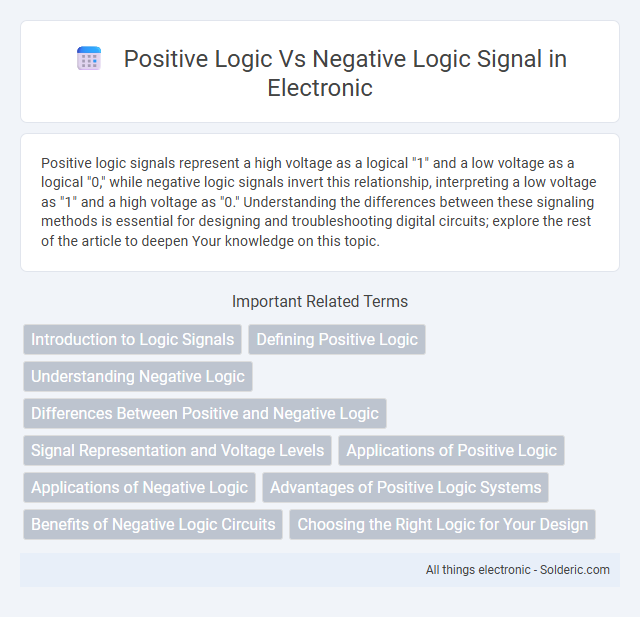Positive logic signals represent a high voltage as a logical "1" and a low voltage as a logical "0," while negative logic signals invert this relationship, interpreting a low voltage as "1" and a high voltage as "0." Understanding the differences between these signaling methods is essential for designing and troubleshooting digital circuits; explore the rest of the article to deepen Your knowledge on this topic.
Comparison Table
| Feature | Positive Logic | Negative Logic |
|---|---|---|
| Definition | Logic "1" represented by high voltage level | Logic "1" represented by low voltage level |
| Logic "1" Voltage | High voltage (e.g., +5V) | Low voltage (e.g., 0V) |
| Logic "0" Voltage | Low voltage (e.g., 0V) | High voltage (e.g., +5V) |
| Signal Interpretation | High = True, Low = False | Low = True, High = False |
| Common Use | Standard TTL and CMOS logic circuits | Some communication protocols, active-low signals |
| Advantages | Intuitive voltage-to-logic mapping | Noise immunity in active-low designs |
| Disadvantages | Potential noise on high-level signals | Inversion required in logic design |
Introduction to Logic Signals
Logic signals represent binary states in digital circuits, where positive logic assigns a high voltage level (usually 1) to a logical "true" and a low voltage level (0) to "false". Negative logic reverses this convention, with a high voltage representing a logical "false" and a low voltage indicating "true". Understanding the distinction between positive and negative logic is essential for interpreting circuit behavior and designing compatible digital systems.
Defining Positive Logic
Positive logic defines a signal system where a higher voltage level represents a logical "1" and a lower voltage level represents a logical "0." In digital circuits, positive logic simplifies interpretation by associating the presence of voltage with true or active states. This convention contrasts with negative logic, where logical values are inverted relative to voltage levels.
Understanding Negative Logic
Negative logic signals interpret a low voltage level as a logical "1" and a high voltage level as a logical "0," which contrasts with positive logic where high voltage represents "1." Understanding negative logic involves recognizing its application in digital circuits where active-low signals simplify design and noise immunity by triggering actions when the line is pulled low. This logic convention is common in integrated circuits and microcontroller inputs to optimize power consumption and signal integrity.
Differences Between Positive and Negative Logic
Positive logic uses a high voltage level to represent a binary 1, while negative logic assigns a low voltage level to indicate a binary 1. The primary difference lies in signal interpretation: in positive logic, a high signal is true, whereas in negative logic, a low signal represents true. Understanding these differences helps you design and troubleshoot digital circuits based on the appropriate logic convention.
Signal Representation and Voltage Levels
Positive logic signals represent a logical high (1) with a higher voltage level, typically close to the supply voltage (e.g., +5V or +3.3V), and a logical low (0) with a voltage near ground (0V). Negative logic signals invert this convention, representing a logical high (1) at a lower voltage level close to ground and a logical low (0) near the supply voltage. Voltage thresholds defining these logic levels vary with technology standards but commonly maintain clear distinctions to ensure proper signal interpretation and noise immunity.
Applications of Positive Logic
Positive logic signals are widely used in digital circuits where a high voltage level (logic 1) represents the true or active state, simplifying the design of combinational and sequential logic systems. Applications include microprocessor inputs, memory storage elements, and communication interfaces, where clear signal interpretation enhances reliability and noise immunity. Positive logic also facilitates easier integration with standard TTL and CMOS logic families, optimizing circuit compatibility and performance.
Applications of Negative Logic
Negative logic signals are widely used in digital circuits where active-low signals improve noise immunity and reduce power consumption, common in microprocessor design and memory devices. Applications include enable lines, reset functions, and chip select signals, where a low voltage level triggers the desired operation, enhancing circuit reliability. Negative logic is also favored in wired-AND configurations and open-collector/open-drain outputs to facilitate multiple device communication on a shared bus.
Advantages of Positive Logic Systems
Positive logic systems offer clearer signal interpretation due to their convention of representing a high voltage level as a logical "1," which aligns with most digital circuit designs. These systems simplify troubleshooting and reduce the risk of signal misinterpretation in noise-prone environments, enhancing overall reliability. Positive logic also facilitates easier integration and compatibility with standard logic devices, improving design efficiency and scalability.
Benefits of Negative Logic Circuits
Negative logic circuits offer advantages such as improved noise immunity and simplified wired-AND connections, enhancing signal reliability in digital systems. They allow direct use of open-collector or open-drain outputs, reducing power consumption and component count. Your designs benefit from easier fault detection and compatibility with certain memory and sensor interfaces.
Choosing the Right Logic for Your Design
Choosing the right logic for your design depends on factors such as power consumption, noise immunity, and circuit simplicity. Positive logic, where a high voltage represents logic '1', is intuitive and widely used, offering better noise margins in many systems. Negative logic, which assigns a low voltage to logic '1', can simplify certain circuit implementations and is beneficial in active-low signal environments, improving compatibility and reducing transistor count in some designs.
positive logic vs negative logic signal Infographic

 solderic.com
solderic.com